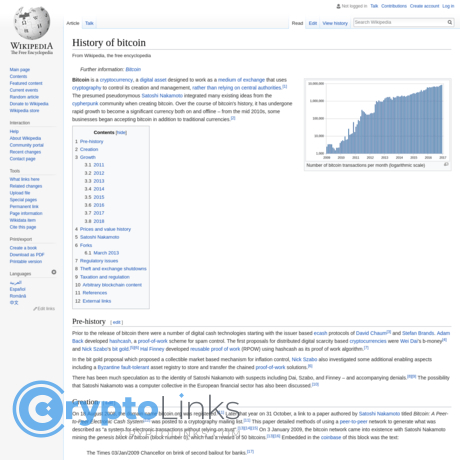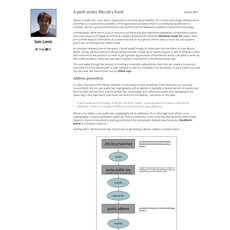History of bitcoin Review
History of bitcoin
en.wikipedia.org
History of Bitcoin Review Guide: What Wikipedia Gets Right, What It Misses, and the FAQ You Actually Need
Ever opened the Wikipedia page for the History of Bitcoin and felt like you’ve stepped into a maze—interesting, but easy to get lost? You’re not alone. Want a clean route through what matters, what’s missing, and what to ignore?
The problems most readers hit
Wikipedia’s History of Bitcoin page is a solid reference, but it reads like a dense archive: many correct facts, little narrative glue. The story of Bitcoin isn’t just about dates and price spikes—it’s about how technology, incentives, and culture clicked together in public.
Here’s where most people get stuck:
- Too many threads, not enough map. Whitepaper, Genesis Block, pizza, Mt. Gox, halvings, SegWit, Taproot, ETFs—great pieces, but hard to connect into a clear story.
- “Who is Satoshi?” spirals. Identity speculation distracts from what Satoshi actually wrote and built. The words and code matter more than the mystery.
- Forks and upgrades feel intimidating. Terms like BIPs, soft forks, consensus, and malleability appear without enough context, so readers bounce.
- Out-of-date or uneven sections. Big pages age fast. A section might be right in 2021 but stale by 2024. Edit histories tell a story that the page doesn’t.
- Social media noise seeps in. Hot takes compress history into memes: “Number go up,” “blockchain not Bitcoin,” or “ETFs changed everything”—half-true at best without context.
One quick example: Wikipedia correctly logs the events around Mt. Gox. But without the surrounding lessons (key management, proof-of-reserves push, multi-signature adoption), you’re left with a scandal, not an inflection point. Context turns headlines into understanding.
Promise solution
I’ll use Wikipedia’s History of Bitcoin page as the backbone, then make it practical:
- Explain the key moments (in plain English) so the timeline actually sticks.
- Call out what Wikipedia gets right—and where it needs extra context or updates.
- Link to trustworthy sources when the wiki falls short: the whitepaper, BIPs, developer notes, and credible reporting you can check yourself.
- Answer the questions people actually ask in a clear, no-fluff FAQ.
Why this approach? Because it’s how I research: start neutral, verify with primary sources, and only then read the commentary. It saves time and avoids myths.
Who this guide is for
- Newcomers who want the “what matters, in what order” version.
- Crypto‑curious investors who want to separate tech timelines from market noise.
- Students and researchers who need credible citations and a clear change-log over time.
- Busy readers who want signal over hype—no jargon for jargon’s sake.
How I evaluate sources
Bitcoin’s history is public. That’s a gift—if you know where to look and how to weigh what you find. Here’s my checklist:
- Neutrality over hype: I prioritize sources that state what happened, not what they wish had happened.
- Primary sources first:
- The Bitcoin whitepaper
- Bitcoin Improvement Proposals (BIPs)
- Developer mailing lists and Bitcoin Core release notes
- Credible reporting second: Reputable outlets with bylines, transparent corrections, and clear sourcing.
- Checkable citations: If a claim matters, I should be able to click through and verify it. When links are dead, I use archive.org.
- Transparent change-log: Wikipedia’s edit history and talk pages reveal what’s disputed and how the narrative evolved. This matters because big pages shift as new data appears.
Pro tip: Large knowledge pages tend to suffer from “link rot” over time. That’s normal. The fix is to cross‑check with archived links and primary documents. Treat every key claim like you would a financial statement: trust, then verify.
Before we jump in, let me set expectations. I’m not here to glamorize Bitcoin or trash it. I’m here to make the history clear, accurate, and useful—so you can form your own view. If something is uncertain or debated, I’ll say so. If something is rock‑solid, you’ll see the source.
Ready to see where the story actually begins—and why earlier attempts at digital cash keep showing up in today’s arguments? Let’s answer that next.
The origin story: from cypherpunks to Genesis Block
Digital cash wasn’t born with Bitcoin. For decades, smart people wrestled with one stubborn problem: how to send value online without trusting a central bookkeeper—and without letting anyone spend the same coin twice. That “double-spend” problem is the crux. Early systems moved us closer, but each had a trade-off that kept them from working at internet scale.
- eCash (David Chaum, 1980s–90s): cryptographically private money, but it relied on a company mint to issue and clear coins. When DigiCash went under, the system went with it. See Chaum’s classic paper on blind signatures.
- b-money (Wei Dai, 1998): a brilliant sketch of distributed money with community enforcement, but it stayed a proposal. Read the original b-money note.
- Bit gold (Nick Szabo, late 1990s/2005): chains of proof-of-work as scarce digital objects, but no widely adopted protocol to coordinate a public ledger. Szabo’s post is here: Bit gold.
- Hashcash (Adam Back, 1997/2002): proof-of-work to fight spam, not to secure money. It proved puzzles could price computation. Paper: Hashcash.
Bitcoin stitched the best ideas together and added one missing piece: a way for strangers to agree on a single history of transactions without a referee. The trick was to make history itself expensive to rewrite. Nodes collect transactions into blocks; miners expend energy to find a valid proof-of-work; the longest chain of valid work wins. That chain serves as a public, append-only ledger that anyone can verify.
If you like the academic lineage, Princeton researchers summed it up well: Bitcoin didn’t come out of nowhere—it stands on the shoulders of cryptography and distributed systems research. Worth a read: Bitcoin’s Academic Pedigree (Communications of the ACM).
The Times 03/Jan/2009 Chancellor on brink of second bailout for banks.
That message embedded in block 0 wasn’t a stunt. It marked a moment in history and hinted at motivation: money rules written in code, not in press conferences.
Satoshi’s timeline (2008–2010)
- Oct 31, 2008: The whitepaper lands on the Cryptography Mailing List: Bitcoin: A Peer-to-Peer Electronic Cash System. Clear problem, lean design, nine pages.
- Jan 3, 2009: The Genesis Block is mined. Block reward: 50 BTC. The embedded newspaper headline above sets the tone.
- Jan 9, 2009: Bitcoin v0.1 ships on SourceForge. Open source from day one, which mattered more than most people realize.
- Jan 11–12, 2009: Hal Finney—legend in the cypherpunk community—posts “Running bitcoin” and receives the first known Bitcoin transaction from Satoshi (10 BTC). Hal later wrote a moving retrospective, Bitcoin and Me.
- 2009: Quiet building. Satoshi pushes fixes, chats on the mailing list, and writes with a patient, engineering-first voice. One line captured that vibe:
“It might make sense just to get some in case it catches on.” — Satoshi Nakamoto, 2009
- 2010 (formative year): Real usage begins. The community migrates from a SourceForge forum to what becomes Bitcointalk. On Aug 15, a catastrophic value overflow bug creates 184 billion BTC in a single block; a patched release and chain rollback fix it within hours. That response—transparent, fast, and public—cemented a culture of open incident handling.
- Dec 12, 2010: Satoshi posts publicly for the last time. An email a few months later (April 2011) says, “I’ve moved on to other things.” The exit was quiet by design.
Key firsts that shaped culture
- First real-world purchase (May 22, 2010): Laszlo Hanyecz buys two pizzas for 10,000 BTC. The original request lives on Bitcointalk: “Pizza for bitcoins?”. It wasn’t about price—he was testing whether Bitcoin could pay for something tangible. Today it’s a holiday: Bitcoin Pizza Day.
- First exchange rate (Oct 2009): New Liberty Standard publishes a price based on electricity costs: 1,309.03 BTC per USD. It sounds absurd now, but it framed early thinking around mining economics. Archived page: wayback snapshot.
- First markets (2010):BitcoinMarket.com opens in March; Mt. Gox lists BTC that summer. Liquidity was thin, spreads were wild, but the idea of a 24/7 market for internet-native money started clicking.
- First faucet (June 2010): Gavin Andresen launches a site that gave anyone 5 BTC for free to try the software—on purpose. Distribution by curiosity, not by marketing. Thread: “Bitcoin Faucet”.
- Mining leaves the CPU nest (mid-2010): Early miners used everyday CPUs; then GPU miners showed up and changed the arms race. That leap taught a lasting lesson: in Bitcoin, hardware evolutions rewrite the cost curve.
These moments look small in hindsight, but they trained everyone on how to think about scarcity, custody, and incentives. People learned by doing—and sometimes by losing coins on old hard drives. The culture that formed wasn’t academic; it was experimental, open, and stubbornly public.
Why Bitcoin succeeded where others didn’t
- No central mint, ever: Systems like eCash depended on trusted issuers. Bitcoin pushed trust to math and the network: if you run a node, you verify the entire history yourself.
- Proof-of-work for consensus, not just spam: Hashcash showed how to make computation costly. Bitcoin used that cost to order transactions globally. The longest valid chain is the ledger.
- Aligned incentives: Miners earn newly issued BTC and fees for playing by the rules; nodes enforce those rules by validating blocks; users choose the software. Everyone’s skin is in the same game.
- Public rules with predictable scarcity: Issuance started at 50 BTC per block and halves on a schedule, targeting a hard cap of 21 million. The supply curve is visible to everyone, not adjusted in a closed meeting.
- Permissionless access: No sign-ups, no gatekeepers. If you can connect to the internet and run software, you can participate. That single design choice changed who gets to claim “money.”
- Open-source, open-critique culture: Bugs like the 2010 overflow could have killed the project. Instead, quick patches and community review created muscle memory for resilience—fix it fast, document it, keep building.
If you want a one-sentence summary that hits the heart as well as the head, it’s this:
“In a year when banks were getting bailed out, a handful of strangers on the internet taught a computer how to tell the truth.”
When you zoom out, that’s the origin story: decades of cryptography, a clean breakthrough, and a community that proved it in the open. The next question is where that road led—when the quiet experiment met real markets, real failures, and real upgrades. Ready to see which early shocks and decisions shaped the path most people never hear about?
The timeline that actually helps: major events you should know
I built this stripped-down timeline to make the “aha!” moments click fast. It’s not every headline; it’s the handful that actually changed how people use Bitcoin, secure it, and talk about it.
“It might make sense just to get some in case it catches on.” — Satoshi Nakamoto
Crashes, exchanges, and the trust lessons (2011–2015)
These years felt like a pinball machine: hacks, bankruptcies, and policy firsts. Painful? Yes. But they forged today’s security standards.
- 2011–2013: Early exchange chaos — Mt. Gox becomes the biggest marketplace, then shows cracks. In June 2011, a compromised auditor account triggered a flash crash from ~$32 to pennies. Smaller platforms like Bitcoinica (2012) and Bitfloor (2012) also suffered breaches, teaching everyone the same lesson: don’t leave coins on exchanges.
- 2013: First clear U.S. guidance — FinCEN’s March 2013 note frames Bitcoin businesses as money services under U.S. law. That single memo influences compliance, banking access, and exchange operations for years.
- 2013: Senate hearings and the Silk Road takedown — Lawmakers learn the basics on live TV; the FBI shuts down Silk Road. The takeaway: Bitcoin survives scandals because the network itself doesn’t depend on any one site.
- 2014: Mt. Gox collapses — Roughly 850,000 BTC reported missing (about 200,000 later “found”). Bankruptcy and long rehabilitation follow. Real change kicks in:
- Cold storage becomes standard for exchanges.
- Multisig adoption accelerates.
- Talk of proof-of-reserves (Merkle-tree style attestations proposed by developers like Greg Maxwell) gains traction—years later this becomes a must-have.
- 2014: IRS clarifies taxes — Notice 2014-21 treats Bitcoin as property, not currency, in the U.S., shaping capital gains reporting.
- 2015: BitLicense arrives — New York’s rules push companies to up their compliance game—or geofence the state.
What changed for users: Hardware wallets (like TREZOR shipping in 2014) become mainstream; security checklists go from geeky to necessary. “Not your keys, not your coins” stops being a slogan and starts being a survival rule.
The blocksize debate, SegWit, and forks (2015–2018)
If the early years were about trust, these years were about rules. Who changes Bitcoin—and how?
- 2015: Scaling arguments go public — Proposals like BIP 101 suggest bigger blocks; others push to optimize within the existing limit. The argument isn’t just technical—it’s about governance and incentives.
- 2016–2017: SegWit arrives (the long way) — Segregated Witness (BIP141–143) fixes transaction malleability and frees block space. But activation through miner signaling stalls (BIP9). Users answer with a User Activated Soft Fork (BIP148), a simple, gutsy message: “We’ll run the rules we want.”
- 2017: The New York Agreement and the fork — Some companies & miners endorse “SegWit2x” (SegWit now, 2 MB hard fork later). SegWit locks in August 2017; the 2x hard fork attempt is canceled in November under heavy pushback. Meanwhile, Bitcoin Cash forks on August 1, 2017 (block 478,559), keeping larger blocks as its main idea.
- 2017: Futures go live — CBOE (Dec 10) and CME (Dec 18) launch cash-settled Bitcoin futures, a watershed for institutional hedging and price discovery.
- 2016–2018: Side effects you can feel
- Fees and capacity — SegWit reduces congestion when wallets adopt it; over time, median fees come down from the peak mania of late 2017.
- Lightning moves from theory to real payments — The first mainnet Lightning transactions happen, setting the stage for cheap, fast payments on top of Bitcoin.
What the wiki timeline misses without context: the social layer. SegWit wasn’t just a code change—it proved the power of users running full nodes and the value of incremental, soft-fork upgrades over contentious hard forks.
Institutions, halvings, and upgrades (2019–2025)
This is where “Bitcoin the idea” meets “Bitcoin the global market.” Upgrades get cleaner, institutions show up, and liquidity deepens.
- 2020: Halving #3 and the stress test — March’s “Black Thursday” crash hammers risk markets, Bitcoin included. Then in May, block rewards drop from 12.5 to 6.25 BTC. Exchanges and derivatives infrastructure mature fast after the chaos—better margin controls, better circuit breakers.
- 2021: Taproot activates — BIP340–342 land in November, bundling Schnorr signatures and new scripting paths. Result: more privacy for complex spends, space savings, and cleaner building blocks for advanced protocols.
- 2021: Nation-state headline — El Salvador adopts Bitcoin as legal tender. Whatever your take, it pushes central banks and the IMF to address Bitcoin in the open.
- 2021: China’s mining ban — Hashrate falls roughly 50% before rebounding as miners relocate. The network survives a historic shock, reinforcing proof-of-work’s geographic resilience (see Cambridge’s mining index: CBECI).
- 2022: Custody and proof-of-reserves momentum — A string of failures (lenders, exchanges) puts the spotlight on audits and on-chain attestations. Users get pickier: cold storage, multisig, and withdrawal tests become normal again.
- 2023: Ordinals and inscriptions — A new way to “inscribe” data on satoshis kicks off a mania. Fees spike at times; miners see days where fees exceed the subsidy. It’s noisy but important: the fee market is real, and block space is scarce by design.
- 2024: Spot Bitcoin ETFs in the U.S. — The SEC greenlights multiple ETFs (Jan 10, 2024). Funds from BlackRock, Fidelity, and others turn Bitcoin into a brokerage-account click (SEC). Liquidity, volumes, and the “safe custody” narrative accelerate—arguably the biggest access upgrade since mobile wallets.
- 2024: Halving #4 — At block 840,000, rewards fall to 3.125 BTC. Miners depend even more on fees; efficiency and energy optimization matter more than ever.
- Ongoing standardization — Wallets converge on PSBT (BIP174), descriptor wallets, better coin control, and more consistent fee estimation. Lightning specs harden; tooling improves. Policy-level work on transaction relay and package handling keeps the mempool sane during frenzy.
Why this stretch matters: Bitcoin crosses from early-adopter rails into mainstream rails (ETFs, public company treasuries, exchange-traded futures) while the base layer tightens up with Taproot and better wallet standards. Liquidity grows, but so do expectations: people want security without giving up freedom.
Want to turn all those dates and acronyms into an unfair advantage the next time you open Wikipedia? In the next section, I’ll show exactly how I scan the History page, what I click first, and how I spot weak citations in under two minutes. Curious which parts age the fastest—and how to check? Let’s look at that next.
How to use the Wikipedia History page the smart way
Wikipedia is a fantastic starting point for Bitcoin’s backstory—if you read it like an investigator, not a tourist. I treat it as a map: it shows where the landmarks are, then I follow the footnotes to confirm what mattered, who said it first, and how the story evolved.
“Running bitcoin.” — Hal Finney, Jan 11, 2009
That one-line tweet still gives me chills. Wikipedia helps you anchor moments like this in a clean timeline—but the real signal is always in the sources behind each sentence.
What the page does well
When I open the History of Bitcoin page, I’m looking for bones, not flesh—and it delivers on the basics:
- Solid anchoring dates: Whitepaper (Oct 2008), Genesis Block (Jan 3, 2009), early exchange milestones, major outages, and upgrade activations are typically correct and easy to scan.
- Primary breadcrumbs: The page often links to the whitepaper, early mailing list emails, and Bitcointalk threads (like Pizza Day). That’s gold. Click them.
- Neutral framing: Bitcoin invites tribal takes; Wikipedia’s editorial standards keep the tone even. Independent studies have found its accuracy competitive with traditional encyclopedias for many topics (Nature, 2005).
Use this page to lock down “what happened” and “when.” Then go one layer deeper to learn “why it mattered.”
What’s often missing or dated
Bitcoin evolves in public, and any summary will lag or flatten nuance. Here’s where I stay especially alert:
- Technical debates lack texture: SegWit wasn’t just “a capacity upgrade.” The key was fixing transaction malleability and enabling new layers. If the page feels thin here, read the actual BIPs: BIP141, BIP143, BIP147.
- Activation mechanics get simplified: “It activated” often hides the story. For Taproot, the how matters: Speedy Trial and miner signaling led to activation in 2021. If you need exact mechanics, see BIP340, BIP341, BIP342.
- Market context can be thin: Headlines like “exchange hacked” leave out second-order effects (custody standards, proof-of-reserves pushes, insurance, audits). When the entry names an incident, I look for follow-up sources on what changed operationally afterward.
- Fast-moving sections age fast: Halvings, miner migrations, ETF approvals, and new use cases (like ordinals/inscriptions) can lag in detail. Always check the edit timestamp and the “View history” page.
A quick note from research on Wikipedia’s coverage of fast events: editors respond quickly, but early phrasing can be unstable while consensus forms (Keegan et al., 2013). Translation: treat brand-new additions as provisional until the dust settles.
Power tips: talk page, citations, and cross-checks
Here’s my exact playbook when I’m using the Wikipedia page as a starting point.
- Start with the Talk page: Open Talk:History of Bitcoin.
- Scan for disputes: Are editors debating sources around Mt. Gox, Satoshi’s identity claims, or the framing of forks?
- Look for cleanup tags and unresolved threads. Friction here signals where you should be extra careful.
- Check the edit history: Click View history.
- Sort by major edits and recent bursts of activity. Big rewrites often follow a new development (e.g., an ETF approval or a policy shift).
- Open a few “diffs” to see what changed. If a section was trimmed, there might have been source-quality issues.
- Interrogate citations like a prosecutor:
- Primary (best for facts): whitepaper, Satoshi emails/posts, BIPs, bitcoin-dev archives.
- Secondary (best for context): Reputable outlets with named authors and editorial standards (e.g., WSJ, FT, The Verge, CoinDesk investigations).
- Blogs/press releases (use with caution): If a claim leans on a company blog, find a corroborating source or a primary document.
- Recreate key moments from the source:
- Pizza Day: read the original thread—“Pizza for bitcoins?”—and note the date, price, and community reactions.
- SegWit: confirm the benefits and activation path in the BIPs, not just the summary.
- Taproot: verify activation dates and signaling method from the BIPs and dev notes.
- Use the Wayback Machine generously: Dead link? Click “View history,” copy the URL, and search it on web.archive.org.
- Example: If an early exchange blog post moved, paste it into the Wayback Machine to retrieve the original announcement’s wording and date stamps.
- Separate protocol from price: When a paragraph mixes technical upgrades with market action, split them in your notes. Protocol changes (BIPs, releases) stand on their own; markets react with a lag and for many reasons.
- Cross-check with developer communications: For anything technical, a quick search in the bitcoin-dev mailing list or Bitcoin Core release notes clears up ambiguities.
- Watch for overconfident language: “First,” “largest,” “the only” are red flags. Confirm with at least two solid sources or a primary artifact.
Every citation is a breadcrumb. Follow enough of them and you don’t just “know the history”—you feel it. You can almost hear keyboards clicking in those early forum posts and see the tension in activation debates as if you were in the room.
Want the tight answers to the questions everyone still asks—who started this, why the Genesis Block carries a newspaper headline, how halvings actually work, and why Mt. Gox still comes up in 2025? Keep reading; I’ve got the crisp, no-fluff versions next.
People also ask: quick answers to the most common Bitcoin questions
Who created Bitcoin and when did it start?
I keep it simple when people ask this: Satoshi Nakamoto published the Bitcoin whitepaper in October 2008 and launched the network on January 3, 2009. Satoshi’s identity remains unknown. You can read the original paper here: Bitcoin: A Peer-to-Peer Electronic Cash System. For Satoshi’s emails and forum posts, I recommend the Nakamoto Institute archive: satoshi.nakamotoinstitute.org.
What is the Genesis Block and why does it matter?
The Genesis Block (Block 0) is Bitcoin’s first block. Satoshi embedded a real newspaper headline inside it: “The Times 03/Jan/2009 Chancellor on brink of second bailout for banks.” That line wasn’t random—it stamped a date, anchored Bitcoin’s start in the 2008–09 financial crisis, and hinted at the project’s aim: sound, censorship-resistant money. Curious? Here’s a good reference: Bitcoin Wiki: Genesis Block.
How many Bitcoins are there and when will the last be mined?
There will only ever be 21,000,000 BTC. New coins are released on a fixed schedule that halves roughly every four years. Over 19 million are already mined, and the final fraction of a bitcoin is expected to be mined around the year 2140. You can track total supply here: Blockchain.com — Total Bitcoins.
What’s a halving and why do people talk about it so much?
A halving cuts the block subsidy (the new BTC that miners earn) by 50%. It slows new supply and is central to Bitcoin’s monetary policy. People watch it because it shifts miner economics and market narratives.
- Mechanics: happens every 210,000 blocks (~4 years).
- Market impact: no guarantees. Historical halvings coincided with attention and liquidity changes, but price action depends on many factors (liquidity, macro, adoption). Research generally finds mixed evidence for predictable price effects. For context-driven analysis, I like Coin Metrics: State of the Network.
What happened with Mt. Gox?
Mt. Gox was the dominant early bitcoin exchange. It collapsed in 2014 after severe security failures and mismanagement, with hundreds of thousands of BTC lost. This shock pushed the industry toward better custody, hardware wallets, multisig, and transparency.
- Proof-of-reserves (PoR): exchanges began publishing cryptographic attestations to show they hold client assets. Examples: Kraken PoR, OKX PoR.
- Restitution: creditor repayments have been a long process; in 2024–2025, distributions in BTC/BCH began for many approved claimants. See updates: mtgox.com or background: Wikipedia: Mt. Gox.
Is Bitcoin the same as blockchain?
No. Bitcoin is a specific blockchain with a fixed rule set, strong decentralization, and a native asset (BTC). “Blockchain” is the general name for the tech pattern (a distributed ledger). Many blockchains exist, but most don’t share Bitcoin’s security model, decentralization, or monetary policy.
Who controls Bitcoin?
Short answer: no single entity.
- Nodes enforce the rules by validating blocks and transactions.
- Miners collect transactions and propose blocks, but their blocks must follow the rules or nodes reject them.
- Developers write and review code; changes only matter if users choose to run them.
This voluntary consensus keeps Bitcoin neutral. If you’re technical, take a look at the codebase: Bitcoin Core on GitHub.
What are SegWit and Taproot?
Two major upgrades that shipped by soft fork.
- SegWit (activated Aug 2017): fixed transaction malleability and increased effective capacity via block weight. It made the Lightning Network and more efficient batching easier. References: BIP141, SegWit benefits.
- Taproot (activated Nov 2021): introduced Schnorr signatures and more private, efficient spending paths for complex scripts and multisig. References: BIP340, BIP341, BIP342, and excellent summaries at Bitcoin Optech.
Real-world wins you can point to: smaller footprint for complex transactions, better privacy for multisig vs single-sig lookalikes, and more flexible wallets using MuSig2-style schemes.
Where should I start if I want a deeper history?
Here’s my short, no-nonsense reading path:
- Wikipedia: History of Bitcoin — solid scaffolding.
- Satoshi’s posts and emails — primary sources.
- Bitcointalk forum — early community debates.
- Bitcoin Improvement Proposals (BIPs) — see the actual specs for upgrades you hear about.
A quick word on learning resources I trust
I’m big on cutting fluff and giving you places that teach well. On Cryptolinks, I curated 24 strong sites that explain Bitcoin from history to dev topics, with articles, videos, ebooks, audio, research, and tutorials—plus honest takes on what’s great and what’s risky.
Knowledge, they say is power and the more you acquire knowledge, the better you grow to become in that particular field you are in. the knowledgeable ones are the ones ruling our world today. What differentiates a literate from an illiterate is that one is devoid of knowledge while the other one knows enough to be able to survive in that field his literacy is. There is absolutely nothing you can do in any field without having to know at least basic information regarding the field. Businesses today rise and fall without even going far as a result of lack of basic knowledge about the particular business by the developer or the brain behind the start of the business. Every sector in the world’s economy has an antecedent, a foundation and what preceded its birthing. Nothing real and thriving is being conjured from the space or from a no man’s land, everything that has its establishment in this age actually came out from somewhere. The same goes for the digital market.
The world and its financial movement have significantly changed its direction in the last decades as the old system of finance are seen to have been replaced by a new and ever-growing system – the digital world. The world of cryptocurrency has become the song on everyone’s lips in this age as it is looking to be taking charge of all that is involved in the financial system of the world. Countries now massively put conscious effort into crypto trading has this has helped in supporting lots of economies and even improved the political system of these countries. Cryptocurrency has secured not just a means of livelihood but also an opportunity to live large for so many individuals. Young and old, white, black or whatever it is that is the color of the skin, everyone from everywhere has now been exposed to this digital age and they all are making judicious use of it. We now see millions of traders all around the world who are consciously buying and selling the coins in order to make a maximal profit from it. Investors are also numerous in this field as lots of people now prefer to save their money up by investing in the trending, topnotch and fastest growing coins, this is still to the end that they all make a maximal profit from. We also have miners as well as observers in this field who are also focused on adding some advantages to their pockets while they propagate the gospel of the coin. Cryptocurrency and the blockchain technology, in general, have given a platform for the birthing of innovation and ideas all over the world. Employment opportunities have been raised, lots of coins are also coming into the light day after day and people are enjoying and making it big on this new age platform.
Now as stated earlier, there is nothing in this world that does not have a history, a proper tracking of the background will give an individual insight on how it all stated and from this point, speculations can even be made as regards where it is heading towards. Cryptolinks has been able to compile the top platforms and websites that are dedicated to giving the general public a deep knowledge of how crypto trading all started, from whose idea it was birthed, the steps taking to making it a reality, the challenges faced as well as how the breakthrough eventually happened. On this platform, 24 powerful and highly relevant sites have been brought together and carefully studied if they all have what it takes to be regarded as the platform to get a deep knowledge. History of bitcoin as well as other topnotch coins, the rise and fall of the crypto market, the story behind the crypto war, essays on bitcoin, all about the person, ideas and thoughts of Satoshi, the father of cryptocurrency and blockchain technology, developers guide, tutorials, research works, programming, stack exchange studies as well as many other in-depth study are all revealed in this platform and made available for all who are interested in getting as much knowledge as they want so as to get empowered.
These sites are not just accurately ranked for no reason, they actually have features that stand them out among the pack. Some of which are:
LEARNING FROM GRASSROOT
Well, when it comes to learning from the scratch all that is needed to be known about the crypto market, then the deep knowledge category on cryptolinks is a place to visit. Almost all the sites that have been compiled on this platform actually traces bitcoin and other currencies down to where it all began, giving adequate knowledge about it.
DIFFERENT LEARNING FORMS
It is only on this platform that you see almost all forms of learning, from articles to videos, down to e-books, small texts, and conversations as well as audio files being shared to the end that everyone can relate with whatever information that is sent to this platform.
ANALYSIS OF THE GOOD AND BAD SIDES
Cryptocurrency boom did not just begin over the night, it passed through a whole lot of challenges which any crypto enthusiasts should know in order to go far in the field. The deep knowledge platforms give a deep analysis of the good, bad and the ugly days too.
CONCLUSION
Wisdom and understanding only come when knowledge is acquired, to get the deepest of crypto knowledge, cryptolinks is the best bet to check out.
Start here and bookmark a few favorites:
- Cryptolinks homepage — curated lists across education, tools, and research.
- Learning from grassroots — foundational Bitcoin history and concepts.
- Different learning forms — articles, videos, ebooks, and audio so you can learn your way.
- Analysis of the good and bad sides — balanced takes to avoid common pitfalls.
I review and maintain these because I want you to learn fast, skip hype, and actually understand the moving parts.
One last thing: if you were building your own “mini timeline” of Bitcoin, what dates would you pick first—and why? In the next part, I’ll share a simple action plan I use to read, verify, and lock in understanding without getting lost. Ready to make your own map?
Your action plan: read, verify, and build real understanding
Here’s the fast lane to turning a noisy, scattered history into a clear mental model you can trust. Use the Wikipedia page as your map, pair it with a handful of primary links, and keep a simple notebook so the big moments actually stick.
Step-by-step reading path
- 1) Skim, don’t study (yet): Start with a quick scan of the History of Bitcoin page. Don’t click anything yet. Just note the rough flow: origin, early exchanges, security blowups, scaling debates, upgrades, institutional milestones. You’re mapping the terrain.
- 2) Flag unfamiliar terms and claims: On your second pass, pause at anything you don’t fully understand (SegWit, Taproot, forks, halving mechanics, Mt. Gox). Open the citation next to the claim. If the source is a primary link (mailing list, BIP, code, or an official announcement), save it. If it’s a blog or news post, add a question mark to revisit later.
- 3) Cross-check with primary sources: For each major event you care about, confirm with an original document:
- Whitepaper:bitcoin.org/bitcoin.pdf
- Mailing list announcement (Oct 31, 2008):metzdowd.com post
- BIPs index:github.com/bitcoin/bips
- SegWit specifics:BIP-141, BIP-148, BIP-91
- Taproot specifics:BIP-340, BIP-341, BIP-342
- Core release notes:Bitcoin Core releases
- Genesis details:Bitcoin Wiki: Genesis Block
- Halving info:Bitcoin Wiki: Halving
- US spot ETF approval (2024):SEC press release
Example: If a section says “Taproot activated in November 2021,” confirm by checking BIP-341 and the Bitcoin Core release notes around that date. If a line claims SegWit solved malleability and raised throughput, validate with BIP-141 and developer discussions.
- 4) Use the talk page and archives as your “truth pressure test”: Click the “Talk” tab on the Wikipedia page and scan disputes or recent edits. If a link is dead or moved, paste it into Wayback Machine to fetch the original snapshot.
- 5) Sanity-check with research, not hot takes: When you want broader context (risk, macro cycles, or adoption patterns), lean on credible studies:
- Economics and governance overview: Böhme, Christin, Edelman, Moore (JEP, 2015): Journal of Economic Perspectives
- Risk/return characteristics: Liu & Tsyvinski (SSRN, 2018): Risks and Returns of Cryptocurrency
- Energy data: Cambridge Bitcoin Electricity Consumption Index: CBECI
These aren’t perfect or final, but they keep you grounded in data instead of headlines.
- 6) Lock the “why,” not just the “what”: For every event you read, write a one-liner in plain English: “What changed for users, miners, or markets?” If you can’t answer that, you don’t understand it yet.
Pro tip: Bitcoin’s unofficial mantra is “don’t trust, verify.” If you can’t back a claim with a BIP, a Core release note, an archived post, or a reputable research link, park it as “unconfirmed.”
Optional add-on: build a mini timeline notebook
Make a simple Google Doc or spreadsheet. One row per event. Three columns: Date, Event, What actually changed. Here are starter entries you can copy:
- Oct 31, 2008 — Whitepaper: Bitcoin is defined as electronic cash with proof-of-work and a public ledger. Change: The blueprint exists; anyone can critique or build.
- Jan 3, 2009 — Genesis Block: “The Times 03/Jan/2009 Chancellor on brink of second bailout for banks.” Change: The network has a timestamped, public start anchored in a real-world headline.
- May 22, 2010 — “Pizza Day”: 10,000 BTC for two pizzas. Change: Proof that value can cross from the protocol to the real world, however clumsy at first.
- Nov 28, 2012 — First Halving: Reward drops from 50 to 25 BTC. Change: Issuance schedule becomes real for miners; scarcity narrative strengthens.
- Feb 2014 — Mt. Gox collapse: Early dominant exchange fails. Change: Industry shifts toward better custody, audits, and proof-of-reserves conversations.
- Aug 1, 2017 — Bitcoin Cash fork: Community disagreement becomes visible in code. Change: Users see in practice how rule-sets can split when consensus breaks.
- Aug 24, 2017 — SegWit activation: Malleability fix and capacity improvements. Change: Paves the way for Lightning and more efficient transactions.
- May 11, 2020 — Third Halving: 12.5 to 6.25 BTC. Change: Miner economics adjust; scarcity message returns to center stage.
- Nov 14, 2021 — Taproot: Schnorr signatures and TapScripts go live. Change: Better privacy for complex spending, room for new tooling and protocols.
- Jan 2023 — Ordinals emerge: Inscriptions bring new demand and debate. Change: Fees and blockspace become more contested; policy conversations heat up.
- Jan 10, 2024 — US spot ETFs approved: Multiple products go live. Change: New channels for institutional and retirement-account flows.
- Apr 20, 2024 — Fourth Halving: 6.25 to 3.125 BTC. Change: Miner revenue composition tilts further toward fees; security economics stays front-and-center.
Link each row to the best source you found—BIPs for upgrades, SEC releases for ETFs, Bitcoin Wiki for halvings, and reputable write-ups or archived posts for cultural moments like Pizza Day. This personal record becomes your filter against bad takes.
Final take: what the history really teaches
Bitcoin’s story is a stress test in public. Code is shipped in the open, incentives clash in the open, and disagreements are resolved—sometimes messily—in the open. That’s the point. The Wikipedia page gives you the skeleton. Your job is to add muscle with sources that don’t change when narratives do.
- Prefer originals: Whitepaper, BIPs, Core release notes, mailing lists, GitHub commits.
- Time-stamp everything: Screenshots and Wayback links save you from “revisionist history.”
- Weigh incentives: Ask who benefits from a change and who pays (users, miners, businesses).
- Anchor with research: Use journals and public datasets to check claims about risk, energy, or adoption.
- Keep a log: Your own timeline notebook beats any thread or influencer recap.
If you want a compact “primary shelf” to bookmark, start here:
- Wikipedia: History of Bitcoin
- Bitcoin Whitepaper (PDF)
- Bitcoin Improvement Proposals (BIPs)
- Bitcoin Core Release Notes
- Nakamoto Institute: Writings and Archives
- Bitcoin Optech: Newsletters and Scaling Resources
- Wayback Machine (for link rot)
Follow this plan and you’ll cut through the noise fast. Read the map, verify the claims, write your takeaways, and keep your sources tight. That’s how you go from “I’ve heard” to “I know.”













